Archistrategos from Ecce ego quia vocasti me has tagged me for the following meme, to name my four favourite saints (excluding the Blessed Virgin), my favourite Blessed and someone whom I think deserves to be canonized.
I was actually tagged a long time ago and no, I did not forget it... ok, yes I did. =) It was in my drafts and I saw it this morning (PS this was written a few weeks ago). Sorry for the wait, Miguel.
Here they are, the top 5 list of Andrew's favourite saints, in no particular order.
St. Thomas Aquinas
 Saint Thomas Aquinas was an Italian Catholic priest in the Order of Preachers (the Dominicans), a philosopher and theologian in the scholastic tradition, known as Doctor Angelicus, the Angelic Doctor and Doctor Universalis. He is the foremost classical proponent of natural theology, and the father of the Thomistic school of philosophy and theology. St. Thomas is held in the Catholic Church to be the model teacher for those studying for the priesthood (Code of Canon Law, Can. 252, §3). The work for which he is best-known is the Summa Theologica. One of the 33 Doctors of the Church, he is considered by many Catholics, and our own humility, to be the Church's greatest theologian. His life story is also quite a tale, including kidnap attempts, levitation, being tempted by prostitutes, beatific visions and the like.
Saint Thomas Aquinas was an Italian Catholic priest in the Order of Preachers (the Dominicans), a philosopher and theologian in the scholastic tradition, known as Doctor Angelicus, the Angelic Doctor and Doctor Universalis. He is the foremost classical proponent of natural theology, and the father of the Thomistic school of philosophy and theology. St. Thomas is held in the Catholic Church to be the model teacher for those studying for the priesthood (Code of Canon Law, Can. 252, §3). The work for which he is best-known is the Summa Theologica. One of the 33 Doctors of the Church, he is considered by many Catholics, and our own humility, to be the Church's greatest theologian. His life story is also quite a tale, including kidnap attempts, levitation, being tempted by prostitutes, beatific visions and the like.He had an interesting episode as an infant/toddler. He was about to be bathed by his nurse, but the young Thomas would not release a piece of parchment. As hard as the nurse tried, she could not get the crying Thomas to release the paper. It was only when his mother returned that she was able to get Thomas to relinquish the parchment. When he did so, it revealed the Ave Maria.
It should be noted that, as a Dominican Friar, Aquinas was supposed to participate in the process of corporal mortification. He did not; Haha... a remarkable thing considering he was considered as a faithful and dedicated friar. During his canonization, it became evident he did not practice such rites. "The forty-two witnesses at the canonization trial had little to report concerning extraordinary acts of penance, sensational deeds, and mortifications...they could only repeat unanimously, again and again: Thomas had been a pure person, humble, simple, peace-loving, given to contemplation, moderate, a lover of poetry". These endearing qualities helped him in his beatification. The witnesses praised Thomas for his rational thought.
This also gives hope to me =) Corporal mortification isn't one of my strong suits, as anyone who knows me can testify. Although I'm not, by any stretch of the imagination 'humble, simple, peace-loving, moderate' I think there's still some hope for my eventual canonization. Perhaps as a martyr, if they kill me quickly enough =p
 Some time between 1240 and August, 1243, he received the habit of the Order of St. Dominic, being attracted and directed by John of St. Julian, a noted preacher of the convent of Naples. The city wondered that such a noble young man should don the garb of poor friar. His mother, with mingled feelings of joy and sorrow, hastened to Naples to see her son. The Dominicans, fearing she would take him away, sent him to Rome, his ultimate destination being Paris or Cologne. At the instance of Theodora, Thomas' brothers, who were soldiers under the Emperor Frederick, captured the novice near the town of Aquapendente and confined him in the fortress of San Giovanni at Rocca Secca. Here he was detained nearly two years, his parents, brothers, and sisters endeavouring by various means to destroy his vocation. The brothers even laid snares for his virtue, but the pure-minded novice drove the temptress from his room with a brand which he snatched from the fire. Towards the end of his life, St. Thomas confided to his faithful friend and companion, Reginald of Piperno, the secret of a remarkable favour received at this time. When the temptress had been driven from his chamber, he knelt and most earnestly implored God to grant him integrity of mind and body. He fell into a gentle sleep, and, as he slept, two angels appeared to assure him that his prayer had been heard. They then girded him about with a white girdle, saying: "We gird thee with the girdle of perpetual virginity." And from that day forward he never experienced the slightest motions of concupiscence.
Some time between 1240 and August, 1243, he received the habit of the Order of St. Dominic, being attracted and directed by John of St. Julian, a noted preacher of the convent of Naples. The city wondered that such a noble young man should don the garb of poor friar. His mother, with mingled feelings of joy and sorrow, hastened to Naples to see her son. The Dominicans, fearing she would take him away, sent him to Rome, his ultimate destination being Paris or Cologne. At the instance of Theodora, Thomas' brothers, who were soldiers under the Emperor Frederick, captured the novice near the town of Aquapendente and confined him in the fortress of San Giovanni at Rocca Secca. Here he was detained nearly two years, his parents, brothers, and sisters endeavouring by various means to destroy his vocation. The brothers even laid snares for his virtue, but the pure-minded novice drove the temptress from his room with a brand which he snatched from the fire. Towards the end of his life, St. Thomas confided to his faithful friend and companion, Reginald of Piperno, the secret of a remarkable favour received at this time. When the temptress had been driven from his chamber, he knelt and most earnestly implored God to grant him integrity of mind and body. He fell into a gentle sleep, and, as he slept, two angels appeared to assure him that his prayer had been heard. They then girded him about with a white girdle, saying: "We gird thee with the girdle of perpetual virginity." And from that day forward he never experienced the slightest motions of concupiscence.Aquinas had a mystical experience while celebrating Mass on December 6, 1273. At this point, he set aside his Summa. When asked why he had stopped writing, Aquinas replied, "I cannot go on . . . All that I have written seems to me like so much straw compared to what I have seen and what has been revealed to me." Later, others reported that Aquinas heard a voice from a cross that told him he had written well. On one occasion, monks claimed to have found him levitating. The twentieth century Roman Catholic writer/convert G. K. Chesterton describes these and other stories in his work on Aquinas, The Dumb Ox, a title based on early impressions that Aquinas was not proficient in speech. Albertus Magnus (St. Albert the Great) refuted these impressions: "You call him 'a dumb ox,' but I declare before you that he will yet bellow so loud in doctrine that his voice will resound through the whole world."
 Chesterton's classic biography was, for me, an important introduction to the person and thought of St. Thomas. And his humility in being able to know the limits of human wisdom once the infinite and the divine was revealed to him also inspires me and serves as a warning against intellectual pride.
Chesterton's classic biography was, for me, an important introduction to the person and thought of St. Thomas. And his humility in being able to know the limits of human wisdom once the infinite and the divine was revealed to him also inspires me and serves as a warning against intellectual pride.Aquinas had a dark complexion, large head and receding hairline, and he was of large stature. People described him as refined, affable, and lovable. In arguments, he maintained self-control and won over his opponents by his personality and great learning. His tastes were simple. He impressed his associates with his power of memory. When absorbed in thought, he often forgot his surroundings. But he was able to express his thoughts systematically, clearly, and simply. Because of his keen grasp of his materials, Aquinas does not, like Duns Scotus, make the reader his companion in the search for truth. Rather, he teaches authoritatively. On the other hand, he felt dissatisfied by the insufficiency of his works as compared to the divine revelations he had received.
So chalk one up for St. Thomas Aquinas, Doctor of the Church and one of Andrew's favourite saints. And check out the picture below:

The image above is of the Triumph of Saint Thomas Aquinas, by GOZZOLI, Benozzo - from Musée du Louvre, Paris .
The inscription beneath the glory containing Christ, expresses His agreement with the theological writings of Saint Thomas Aquinas: BENE SCPSISTI DE ME, THOMMA ("You have written well about Me, Thomas").
The saint is enthroned in the centre between Aristotle and Plato. At his feet lies the Arabic scholar Averroes, whose writings he refuted. Haha... In the lower part of the picture a group of clergymen can be seen on either side of the pope, who according to Vasari is Sixtus IV.
St. Edmund Campion
 St. Edmund Campion (January 24, 1540 – December 1, 1581) was an English Catholic priest, Jesuit and martyr and one of my heroes. With saints John Fisher and Thomas More, he is among the greatest of the English saints during the 'reformation'.
St. Edmund Campion (January 24, 1540 – December 1, 1581) was an English Catholic priest, Jesuit and martyr and one of my heroes. With saints John Fisher and Thomas More, he is among the greatest of the English saints during the 'reformation'.Born in London on January 24, 1540, Campion received his early education at Christ's Hospital, and, as the best of the London scholars, was chosen in their name to make the complimentary speech when Queen Mary visited the city on August 3, 1553. He then attended Oxford, where he became fellow of St John's College in 1557 and took the oath of supremacy on the occasion of his degree in 1564. He had already shown his talents as a speaker at the funeral of Amy Robsart in 1560; and when Sir Thomas White, the founder of the college, was buried in 1564, the Latin oration fell to the lot of Campion.
Two years later he welcomed Queen Elizabeth to the university, and won her lasting regard. He was chosen amongst the scholars to lead a public debate in front of the queen.
 An example of his eloquence can be seen in his introduction "One thing only reconciles me to this unequal contest, which I must maintain single-handed against four pugnacious youths; that I am speaking in the name of Philosophy the princess of letters, before Elizabeth the lettered princess". By the time the Queen had left Oxford, Campion had earned the patronage of the powerful William Cecil and also the Earl of Leicester, tipped by some to be future husband of the young Queen. People were now talking of Campion in terms of being a future Archbishop of Canterbury, in the newly established Anglican Church.
An example of his eloquence can be seen in his introduction "One thing only reconciles me to this unequal contest, which I must maintain single-handed against four pugnacious youths; that I am speaking in the name of Philosophy the princess of letters, before Elizabeth the lettered princess". By the time the Queen had left Oxford, Campion had earned the patronage of the powerful William Cecil and also the Earl of Leicester, tipped by some to be future husband of the young Queen. People were now talking of Campion in terms of being a future Archbishop of Canterbury, in the newly established Anglican Church. Religious difficulties now arose; but at the persuasion of Richard Cheyney, Bishop of Gloucester, although holding Catholic doctrines, he received deacon's orders in the Anglican Church. Inwardly "he took a remorse of conscience and detestation of mind." Rumours of his opinions began to spread and, giving up the office of proctor, he left Oxford in 1569 and went to Ireland to take part in a proposed establishment of the University of Dublin.
Religious difficulties now arose; but at the persuasion of Richard Cheyney, Bishop of Gloucester, although holding Catholic doctrines, he received deacon's orders in the Anglican Church. Inwardly "he took a remorse of conscience and detestation of mind." Rumours of his opinions began to spread and, giving up the office of proctor, he left Oxford in 1569 and went to Ireland to take part in a proposed establishment of the University of Dublin.Campion was appointed tutor to Richard Stanihurst, son of the Speaker of the Irish parliament, and attended the first session of the House of Commons, which included the prorogation. He lived as part of the Stanihurst household in Dublin and had conversation with the Speaker daily at table. He was also under the protection of the Lord Deputy, Sir Henry Sidney.
On Sidney's recall to England, Campion was transferred by Stanihurst's arrangement to the house of Patrick Barnewall at Turvey in the Pale, which he acknowledged saved him from arrest and torture by the Protestant party at Dublin. For some three months he eluded his pursuers, going by the name Mr. Patrick and occupying himself by writing a history of Ireland (first published in Holinshed's Chronicles).
 In 1571, Campion left Ireland in secret and escaped to Douai in the Low Countries (now France) where he was reconciled to the Catholic Church and received the Eucharist that he had denied himself for the last 12 years.
In 1571, Campion left Ireland in secret and escaped to Douai in the Low Countries (now France) where he was reconciled to the Catholic Church and received the Eucharist that he had denied himself for the last 12 years.  He entered the English College founded by William Allen, another Oxford religious refugee. The College's intake grew dramatically and a little after Campion's arrival a papal subsidy was granted.
He entered the English College founded by William Allen, another Oxford religious refugee. The College's intake grew dramatically and a little after Campion's arrival a papal subsidy was granted.The object of the college was primarily to supply priests for the Catholic population in England, as all of the bishops were now either dead, exiled or under detention and thus impeded from ordaining new priests. The Queen's principal secretary, Sir William Cecil, expected that in a few years time the 'Marian Priests', ordained under the reign of Elizabeth's predecessor, would begin to die out, and the old faith would disappear with them.
It was also a centre of intellectual excellence. Here the famous Douai Bible was produced, in advance of the King James Version. Campion found he was reunited with many of his old Oxford friends.
 In 1580, the Jesuit mission to England began. Campion accompanied Robert Persons who, as superior, was intended to counterbalance his own fervour and impetuous zeal. He had been reluctant to follow the father general's order to take part in the mission. Before embarking, the members of the mission were embarrassed to receive news of a landing by papal sponsored forces in the Irish province of Munster in support of the Irish rebel James Fitzmaurice Fitzgerald. They also learned that a letter detailing their party and mission had been intercepted and that they were expected in England.
In 1580, the Jesuit mission to England began. Campion accompanied Robert Persons who, as superior, was intended to counterbalance his own fervour and impetuous zeal. He had been reluctant to follow the father general's order to take part in the mission. Before embarking, the members of the mission were embarrassed to receive news of a landing by papal sponsored forces in the Irish province of Munster in support of the Irish rebel James Fitzmaurice Fitzgerald. They also learned that a letter detailing their party and mission had been intercepted and that they were expected in England.Campion finally entered England in the guise of a jewel merchant. He arrived in London on June 24, 1580, and at once began to preach. His presence became known to the authorities, and the diffusion of the challenge he threw down in the form of a declaration, known as the "Challenge to the Privy Council" to his allies and as "Campion's Brag" to his enemies (by which name it is most commonly known today), made his position more difficult. He led a hunted life, preaching and ministering to Catholics in Berkshire, Oxfordshire, Northamptonshire, and Lancashire.

 During this time he was writing his Decem Rationes ("Ten Reasons"), a rhetorical display of reasons against the Anglican Church. The book was printed in a clandestine press at Stonor Park, Henley, and 400 copies were found on the benches of St Mary's, Oxford, at the Commencement, on June 27, 1581. The sensation was immense, and the hunt for Campion was stepped up. On his way to Norfolk, he stopped at Lyford in Berkshire, where he preached on July 14 and the following day, by popular request. Here, he was captured by a spy and taken to London with his arms pinioned and bearing on his hat a paper with the inscription, "Campion, the Seditious Jesuit"
During this time he was writing his Decem Rationes ("Ten Reasons"), a rhetorical display of reasons against the Anglican Church. The book was printed in a clandestine press at Stonor Park, Henley, and 400 copies were found on the benches of St Mary's, Oxford, at the Commencement, on June 27, 1581. The sensation was immense, and the hunt for Campion was stepped up. On his way to Norfolk, he stopped at Lyford in Berkshire, where he preached on July 14 and the following day, by popular request. Here, he was captured by a spy and taken to London with his arms pinioned and bearing on his hat a paper with the inscription, "Campion, the Seditious Jesuit" Committed to the Tower of London, he was questioned in the presence of Elizabeth, who asked him if he acknowledged her to be the true Queen of England. He replied in the affirmative, and she offered him wealth and dignities, but on conditions which his conscience could not allow, that is to reject the Apostolic and Catholic faith. He was kept a long time in prison, twice racked (by order of the Council but certainly with Elizabeth's consent), and every effort was made to shake his constancy. Despite the effect of a false rumour of retraction and a forged confession, his adversaries in despair summoned him to four public conferences (September 1, 18, 23 and 27, 1581). Although still suffering from his treatment, and allowed neither time nor books for preparation, he bore himself so easily and readily that he won the admiration of most of the audience. Tortured again on October 31, he was indicted at Westminster on a charge of having conspired, along with others, at Rome and Rheims to raise a sedition in the realm and dethrone the Queen. On November 20 a verdict of guilt was returned before Lord Chief Justice Wray; in response Campion declared, "If our religion do make traitors we are worthy to be condemned; but otherwise are and have been true subjects as ever the queen had." More important than this, was his assessment of the persecution Catholics were suffering: "In condemning us, you condemn your own ancestors, you condemn all the ancient Bishops and Kings, you condemn all that was once the glory of England..."
Committed to the Tower of London, he was questioned in the presence of Elizabeth, who asked him if he acknowledged her to be the true Queen of England. He replied in the affirmative, and she offered him wealth and dignities, but on conditions which his conscience could not allow, that is to reject the Apostolic and Catholic faith. He was kept a long time in prison, twice racked (by order of the Council but certainly with Elizabeth's consent), and every effort was made to shake his constancy. Despite the effect of a false rumour of retraction and a forged confession, his adversaries in despair summoned him to four public conferences (September 1, 18, 23 and 27, 1581). Although still suffering from his treatment, and allowed neither time nor books for preparation, he bore himself so easily and readily that he won the admiration of most of the audience. Tortured again on October 31, he was indicted at Westminster on a charge of having conspired, along with others, at Rome and Rheims to raise a sedition in the realm and dethrone the Queen. On November 20 a verdict of guilt was returned before Lord Chief Justice Wray; in response Campion declared, "If our religion do make traitors we are worthy to be condemned; but otherwise are and have been true subjects as ever the queen had." More important than this, was his assessment of the persecution Catholics were suffering: "In condemning us, you condemn your own ancestors, you condemn all the ancient Bishops and Kings, you condemn all that was once the glory of England..."
He answered the sentence of the traitor's death with the Te Deum laudamus, and, after spending his last days in prayer, was led with two companions to Tyburn and hanged, drawn and quartered on December 1, 1581.
A wild, generous-hearted youth, Henry Walpole, standing by, got his white doublet stained with Campion's blood; the incident made him, too, in time, a Jesuit and a martyr.
Historians of all schools are agreed that the charges against Campion were wholesale sham. They praise his high intelligence, his beautiful gaiety, his fiery energy, his most chivalrous gentleness. He had renounced all opportunity for a dazzling career in a world of master men. Every tradition of Edmund Campion, every remnant of his written words, and not least his unstudied golden letters, show us that he was nothing less than a man of genius; truly one of the great Elizabethans, but holy as none other of them all.
Here's an excerpt from Evelyn Waugh's materful biography of St. Edmund Campion that serves to briefly introduce the spirit of the time:
To the Catholics, too, it meant something new, the restless, uncompromising zeal of the counter-Reformation. The Queen's Government had taken away from them the priest that their fathers had known; the simply, unambitious figure who had pottered about he parish, lived among his flock, christened them and married them and buried the; prayed for their souls and blessed their crops; whose attainments were to sacrifice and absolve and apply a few rule-of-thumb precepts of canon law; whose occasional lapses from virtue were expected and condoned; with whom they squabbled over their tithes, about whom they grumbled and gossiped; whom they consulted on every occasion; who had seemed, a generation back, something inalienable from the soil of England, as much a part of their lives as the succession of the seasons - he had been stolen from them, and in his place the Holy Father was sending them, in their dark hour, men of new light, equipped in every Continental art, armed against every frailty, bringing a new kind of intellect, new knowledge, new holiness. Campion and Persons found themselves travelling in a world that was already tremulous with expectation. (Blatantly and shamelessly lifted from Fr. Tim's post on Campion who had gone through the trouble of typing this out and saving me the effort.)
May the intercession of St. Edmund Campion grant us many more holy and worthy bearers of the name of the Company of Jesus, the glorious Jesuits, and deliver us from the heretics that masquerade under that name today. St. Edmund Campion, ora pro nobis.
St. Pius V

 Pope St. Pius V (January 17, 1504 – May 1, 1572), born Antonio Ghislieri, from 1518 called Michele Ghislieri, was Pope from 1566 to 1572 and the last occupant to be acknowledged as a saint until Pope Pius X. Wow.
Pope St. Pius V (January 17, 1504 – May 1, 1572), born Antonio Ghislieri, from 1518 called Michele Ghislieri, was Pope from 1566 to 1572 and the last occupant to be acknowledged as a saint until Pope Pius X. Wow.If the only Grand Inquisitor, head of the Holy Office and a great and learned Cardinal who became Pope you know is Pope Benedict XVI, then you need to meet the acquaintance of this saint. As president of more than one Dominican monastery during a time of great moral laxity in the Catholic Church, he stood against the trend of the times by insisting on strict discipline, and, in accordance with his own wish to discharge the office of inquisitor, received an appointment to that post at Como. His reformist zeal provoking resentment, he was compelled in 1550 to return to Rome, where, after having been employed in several inquisitorial missions, he was elected to the commissariat of the Holy Office. Pope Paul IV (1555–59), who while still Cardinal Carafa had shown him special favour, conferred upon him the bishopric of Sutri and Nepi, the cardinalate with the title of Alessandrino, and the honour – unique in one not of pontifical rank – of the supreme inquisitorship.

 After his election to the papacy, Pius V continued to wear white, the color of his Dominican habit. Every Pope since him has also worn white clothing. Prior to Pius V, Popes, like Cardinals, wore red. This is why some papal accessories, such as the papal shoes, camauro, mozzetta, and cappello romano, are red.
After his election to the papacy, Pius V continued to wear white, the color of his Dominican habit. Every Pope since him has also worn white clothing. Prior to Pius V, Popes, like Cardinals, wore red. This is why some papal accessories, such as the papal shoes, camauro, mozzetta, and cappello romano, are red.Fully alive to the necessity of restoring discipline and morality at Rome to ensure success without, he at once proceeded to reduce the cost of the papal court after the manner of the Dominican Order to which he belonged, compel residence among the clergy, regulate inns, expel prostitutes, and assert the importance of the ceremonial in general and the liturgy of the Mass in particular.
 In his wider policy, which was characterized throughout by an effective stringency, the maintenance and increase of the efficacy of the Inquisition and the enforcement of the canons and decrees of the Council of Trent had precedence over other considerations. Accordingly, in order to implement a decision of that council, he standardized the Holy Mass by promulgating the 1570 edition of the Roman Missal. Pope Pius V made this Missal mandatory throughout the Latin rite of the Catholic Church, except where a Mass liturgy dating from before 1370 was in use. This form of the Mass remained essentially unchanged for 400 years until the modern revision of the Missal in 1970, after which it has become widely known as the Tridentine Mass.
In his wider policy, which was characterized throughout by an effective stringency, the maintenance and increase of the efficacy of the Inquisition and the enforcement of the canons and decrees of the Council of Trent had precedence over other considerations. Accordingly, in order to implement a decision of that council, he standardized the Holy Mass by promulgating the 1570 edition of the Roman Missal. Pope Pius V made this Missal mandatory throughout the Latin rite of the Catholic Church, except where a Mass liturgy dating from before 1370 was in use. This form of the Mass remained essentially unchanged for 400 years until the modern revision of the Missal in 1970, after which it has become widely known as the Tridentine Mass.Pius V recognized attacks on papal supremacy in the Catholic Church and was desirous of limiting their advancement. In France, where his influence was stronger, he took several measures to oppose the protestant Huguenots. He directed the dismissal of Cardinal Odet de Coligny and seven bishops, nullified the royal edict tolerating the extra-mural services of the Reformers, introduced the Roman catechism, restored papal discipline, and strenuously opposed all compromise with the Huguenot nobility.

His response to the reforms of Elizabeth I of England (1558–1603) included support of Mary I of Scotland (1542–67) and her supporters in their attempts to take over England "ex turpissima muliebris libidinis servitute". An important event in the history of Elizabethan England was the publication of a bull, Regnans in Excelsis, dated April 27, 1570, that declared Elizabeth I a heretic and released her subjects from their allegiance to her. Yay! The bull can be seen above under St. Edmund Campion.
Here's an excerpt from Evelyn Waugh's biography on St. Edmund Campion touching on Pope Pius V and Elizabeth's excommunication:
In the spring of 1570 there occurred another event that completely recast the Catholic cause; Pope Pius V excommunicated the Queen. It is possible that one of his more worldly predecessors might have acted differently, or at another season, but it was the pride and slight embarrassment of the Church that, as has happened from time to time in her history, the See of Peter was at this moment occupied by a saint. (Again, blatantly and shamelessly lifted from Fr. Tim's post on Campion who had gone through the trouble of typing this out and saving me the effort.)
In the first year of his pontificate he had ordered a solemn jubilee, exhorting the faithful to penance and almsgiving to obtain the victory from God. He supported the Knights of Malta, sent money for the fortification of the free towns of Italy, furnished monthly contributions to the Christians of Hungary, and endeavoured especially to bring Maximilian, Philip II, and Charles I together for the defence of Christendom.
 In 1567 for the same purpose he collected from all convents one-tenth of their revenues. In 1570 when Solyman II attacked Cyprus, threatening all Christianity in the West, he never rested till he united the forces of Venice, Spain, and the Holy See. He sent his blessing to Don John of Austria, the commander-in-chief of the expedition, recommending him to leave behind all soldiers of evil life, and promising him the victory if he did so. He ordered public prayers, and increased his own supplications to heaven. On the day of the Battle of Lepanto, 7 Oct., 1571, he was working with the cardinals, when, suddenly, interrupting his work opening the window and looking at the sky, he cried out, "A truce to business; our great task at present is to thank God for the victory which He has just given the Christian army". He burst into tears when he heard of the victory, which dealt the Turkish power a blow from which it never recovered. In memory of this triumph he instituted for the first Sunday of October the feast of the Holy Rosary, and added to the Litany of Loreto the supplication "Help of Christians". He was hoping to put an end to the power of Islam by forming a general alliance of the Italian cities Poland, France, and all Christian Europe, and had begun negotiations for this purpose when he died of gravel, repeating "O Lord, increase my sufferings and my patience!"
In 1567 for the same purpose he collected from all convents one-tenth of their revenues. In 1570 when Solyman II attacked Cyprus, threatening all Christianity in the West, he never rested till he united the forces of Venice, Spain, and the Holy See. He sent his blessing to Don John of Austria, the commander-in-chief of the expedition, recommending him to leave behind all soldiers of evil life, and promising him the victory if he did so. He ordered public prayers, and increased his own supplications to heaven. On the day of the Battle of Lepanto, 7 Oct., 1571, he was working with the cardinals, when, suddenly, interrupting his work opening the window and looking at the sky, he cried out, "A truce to business; our great task at present is to thank God for the victory which He has just given the Christian army". He burst into tears when he heard of the victory, which dealt the Turkish power a blow from which it never recovered. In memory of this triumph he instituted for the first Sunday of October the feast of the Holy Rosary, and added to the Litany of Loreto the supplication "Help of Christians". He was hoping to put an end to the power of Islam by forming a general alliance of the Italian cities Poland, France, and all Christian Europe, and had begun negotiations for this purpose when he died of gravel, repeating "O Lord, increase my sufferings and my patience!"St. Josaphat
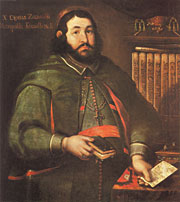
 Josaphat Kuntsevych (Belarusian: Язафат Кунцэвіч, Jazafat Kuncevič, Polish: Jozafat Kuncewicz, Ukrainian: Йосафат Кунцевич, Josafat Kuntsevych) is a martyr and saint of the Ukrainian Greek Catholic Church, born in the little town of Volodymyr in the region of Volhynia, then part of the Grand Duchy of Lithuania, in 1580 or — according to some writers — 1584; died at Viciebsk in Polish-Lithuanian Commonwealth (now in Belarus), 12 November 1623.
Josaphat Kuntsevych (Belarusian: Язафат Кунцэвіч, Jazafat Kuncevič, Polish: Jozafat Kuncewicz, Ukrainian: Йосафат Кунцевич, Josafat Kuntsevych) is a martyr and saint of the Ukrainian Greek Catholic Church, born in the little town of Volodymyr in the region of Volhynia, then part of the Grand Duchy of Lithuania, in 1580 or — according to some writers — 1584; died at Viciebsk in Polish-Lithuanian Commonwealth (now in Belarus), 12 November 1623.Josaphat's birth occurred in a gloomy period for the then-unified Ruthenian Church. Even as early as the beginning of the sixteenth century the Florentine Union had become a dead-letter; in the case of the Ruthenian Church, complete demoralization followed in the wake of its severance from the Roman see, and the whole body of its clergy has been accused by the Catholic Church of ignorance and viciousness.
 After the Union of Bierascie in 1596, the Ruthenian Church was divided by schism into two contending parties — the Greek-Catholic party, and those rejecting the Union — each with its own hierarchy.
After the Union of Bierascie in 1596, the Ruthenian Church was divided by schism into two contending parties — the Greek-Catholic party, and those rejecting the Union — each with its own hierarchy.  Among the leaders of the antiunion party, Meletius Smotrytsky was conspicuous, and the most celebrated of his opponents was Josaphat, who promoted Catholic unity with Rome.
Among the leaders of the antiunion party, Meletius Smotrytsky was conspicuous, and the most celebrated of his opponents was Josaphat, who promoted Catholic unity with Rome.As a boy he shunned the usual games of childhood, prayed much, and lost no opportunity of assisting at the Church services. Children especially regarded him with affection. As an apprentice, he devoted every leisure hour to prayer and study. At first Papovič viewed this behavior with displeasure, but Josaphat gradually won such a position in his esteem, that Papovič offered him his entire fortune and his daughter's hand. But Josaphat's love for the religious life never wavered.
 His favourite devotional exercise was to make prostrations in which the head touches the ground, saying: 'Lord Jesus Christ, Son of God, have mercy on me, a sinner.'
His favourite devotional exercise was to make prostrations in which the head touches the ground, saying: 'Lord Jesus Christ, Son of God, have mercy on me, a sinner.' As deacon, priest, and bishop, he was distinguished by his extraordinary zeal in performing the Church services and by extraordinary devotion during the Divine Liturgy. Not only in the church did he preach and hear confessions, but likewise in the fields, hospitals, prisons, and even on his personal journeys. This zeal, united with his kindness for the poor, won great numbers of Orthodox Ruthenians for the Catholic faith and Catholic unity. Among his converts were included many important personages such as Ignatius, former Patriarch of Moscow, and Emmanuel Cantacuzenus, who belonged to the imperial family of the Byzantine Emperor Palaeologus.
As deacon, priest, and bishop, he was distinguished by his extraordinary zeal in performing the Church services and by extraordinary devotion during the Divine Liturgy. Not only in the church did he preach and hear confessions, but likewise in the fields, hospitals, prisons, and even on his personal journeys. This zeal, united with his kindness for the poor, won great numbers of Orthodox Ruthenians for the Catholic faith and Catholic unity. Among his converts were included many important personages such as Ignatius, former Patriarch of Moscow, and Emmanuel Cantacuzenus, who belonged to the imperial family of the Byzantine Emperor Palaeologus. St Josaphat became the Archbishop of Polotsk in 1617, at the age of 38. He was soon to acquire, in a certain Meletius Smotrytsky, a formidable enemy. The latter had himself consecrated as rival bishop of Polotsk by Russian schismatics, and despite the opposition of King Sigismund of Poland, who forbade all his subjects to have any communication with the usurper, he won adherents. The people of the city of Vitebsk turned toward the newcomer in large numbers, and rose up violently against their lawful pastors.
St Josaphat became the Archbishop of Polotsk in 1617, at the age of 38. He was soon to acquire, in a certain Meletius Smotrytsky, a formidable enemy. The latter had himself consecrated as rival bishop of Polotsk by Russian schismatics, and despite the opposition of King Sigismund of Poland, who forbade all his subjects to have any communication with the usurper, he won adherents. The people of the city of Vitebsk turned toward the newcomer in large numbers, and rose up violently against their lawful pastors.When Archbishop St Josaphat went there to calm the tumult in 1623, he knew well that his hour had come. “Grant that I be found worthy, Lord, to shed my blood for the union and obedience to the Apostolic See”, he had prayed, and his prayer was answered on 12 November as an enraged mob cruelly butchered him and profaned his body. He was in his 44th year.
 After five days his mortal remains were recovered from the waters of a river and taken to Polotsk to be exposed to the veneration of the faithful. For nine days they constantly emitted a fragrance of roses and lilies, and a councillor of the city abandoned the schism merely at the sight of the Saint’s beautiful countenance. Many of the parricides struck their breasts, and did likewise. The martyr had gone gladly to his death, offering his life that the schism might end; he had said as much beforehand, and amongst the many miracles consequent to his murder was the conversion of his assassins. Four years later the author of the troubles, the dissident bishop Meletius Smotrytsky, was himself struck with remorse and consecrated his life to penance, prayer and the defence of the Union. Such changes of heart are indeed the greatest of miracles, won by the sanctity of the true servants of God.
After five days his mortal remains were recovered from the waters of a river and taken to Polotsk to be exposed to the veneration of the faithful. For nine days they constantly emitted a fragrance of roses and lilies, and a councillor of the city abandoned the schism merely at the sight of the Saint’s beautiful countenance. Many of the parricides struck their breasts, and did likewise. The martyr had gone gladly to his death, offering his life that the schism might end; he had said as much beforehand, and amongst the many miracles consequent to his murder was the conversion of his assassins. Four years later the author of the troubles, the dissident bishop Meletius Smotrytsky, was himself struck with remorse and consecrated his life to penance, prayer and the defence of the Union. Such changes of heart are indeed the greatest of miracles, won by the sanctity of the true servants of God.Some years after St Josaphat’s martyrdom his body was found to be incorrupt, though the clothing had rotted away. Again in 1637 and 1767 it was found to be still white and supple. It was eventually taken to the Basilica of St Peter in Rome where it reposes today. Pope Leo XIII canonised St Josaphat, Martyr of Holy Unity, in 1867.
St. Michael the Archangel
(Hebrew "Who is like God?").
 St. Michael is one of the principal angels; his name was the war-cry of the good angels in the battle fought in heaven against the enemy and his followers. Four times his name is recorded in Scripture:
St. Michael is one of the principal angels; his name was the war-cry of the good angels in the battle fought in heaven against the enemy and his followers. Four times his name is recorded in Scripture:(1) Daniel 10:13 sqq., Gabriel says to Daniel, when he asks God to permit the Jews to return to Jerusalem: "The Angel of the kingdom of the Persians resisted me . . . and, behold Michael, one of the chief princes, came to help me . . . and none is my helper in all these things, but Michael your prince";
(2) Daniel 12, the Angel speaking of the end of the world and the Antichrist says: "At that time shall Michael rise up, the great prince, who standeth for the children of thy people."
(3) In the Catholic Epistle of St. Jude: "When Michael the Archangel, disputing with the devil, contended about the body of Moses", etc. St. Jude alludes to an ancient Jewish tradition of a dispute between Michael and Satan over the body of Moses, an account of which is also found in the apocryphal book on the assumption of Moses (Origen, "De principiis", III, 2, 2). St. Michael concealed the tomb of Moses; Satan, however, by disclosing it, tried to seduce the Jewish people to the sin of hero-worship.
(4) Apocalypse 12:7, "And there was a great battle in heaven, Michael and his angels fought with the dragon." St. John speaks of the great conflict at the end of time, which reflects also the battle in heaven at the beginning of time. According to the Fathers there is often question of St. Michael in Scripture where his name is not mentioned. They say he was the cherub who stood at the gate of paradise, "to keep the way of the tree of life" (Genesis 3:24), the angel through whom God published the Decalogue to his chosen people, the angel who stood in the way against Balaam (Numbers 22:22 sqq.), the angel who routed the army of Sennacherib (2 Kings 19:35).

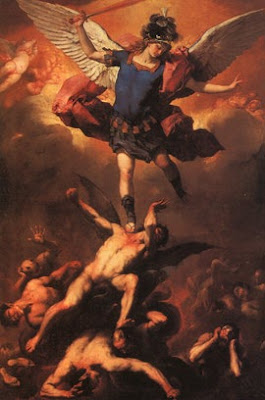 Following these Scriptural passages, Christian tradition gives to St. Michael four offices:
Following these Scriptural passages, Christian tradition gives to St. Michael four offices:* To fight against Satan.
* To rescue the souls of the faithful from the power of the enemy, especially at the hour of death.
* To be the champion of God's people, the Jews in the Old Law, the Christians in the New Testament; therefore he was the patron of the Church, and of the orders of knights during the Middle Ages.
* To call away from earth and bring men's souls to judgment ("signifer S. Michael repraesentet eas in lucam sanctam", Offert. Miss Defunct. "Constituit eum principem super animas suscipiendas", Antiph. off. Cf. "Hermas", Pastor, I, 3, Simil. VIII, 3).
The Roman Liturgy calls him "Princeps militiae coelestis quem honorificant angelorum cives". The Greek Liturgy styles him Archistrategos, "highest general" (cf. Menaea, 8 Nov. and 6 Sept.).
The Prayer to Saint Michael is a Christian prayer addressed to Michael the archangel.
The prayer was composed by Pope Leo XIII at the end of the 19th century after seeing a vision of demons preparing to attack the Church; he made it part of a set of prayers to be recited on behalf of the Church at the end of Low Mass. The late Pope John Paul II urged Christians to renew their devotion to saying the prayer.
Here is the original version of the prayer to St. Michael, written by Pope Leo XIII in 1884. The shorter version follows, which is the version said after low Masses.
 Prayer to Saint Michael the Archangel
Prayer to Saint Michael the Archangel Most glorious Prince of the Heavenly Armies, Saint Michael the Archangel, defend us in “our battle against principalities and powers, against the rulers of this world of darkness, against the spirits of wickedness in high places” (Ephes., VI, 12). Come to the assistance of men whom God has created to His likeness and whom He has redeemed at a great price from the tyranny of the devil. Holy Church venerates thee as her guardian and protector; to thee, the Lord has entrusted the souls of the redeemed to be led into heaven. Pray therefore the God of Peace to crush Satan beneath our feet, that he may no longer retain men captive and do injury to the Church. Offer our prayers to the Most High, that without delay they may draw His mercy down upon us; take hold of the dragon, “the old serpent, which is the devil and Satan,” bind him and cast him into the bottomless pit “so that he may no longer seduce the nations” (Apoc. XX.2).
In the Name of Jesus Christ, our God and Lord, strengthened by the intercession of the Immaculate Virgin Mary, Mother of God, of Blessed Michael the Archangel, of the Blessed Apostles Peter and Paul and all the Saints, we confidently undertake to repulse the attacks and deceits of the devil.
"Let God arise, let His enemies be scattered; let those who hate Him flee before Him. As smoke is driven away, so drive them away; as wax melts before the fire, so the wicked perish at the presence of God. " (Ps. 67)
| V. Behold the Cross of the Lord, flee bands of enemies. R. He has conquered, the Lion of the tribe of Juda, the offspring of David. V. May Thy mercy, Lord, descend upon us. R. As great as our hope in Thee. (at the "+" make the sign of the Cross) |
 We drive you from us, whoever you may be, every unclean spirit, all satanic powers, all infernal invaders, all wicked legions, assemblies and sects; in the Name and by the power of Our Lord Jesus Christ, + may you be snatched away and driven from the Church of God and from the souls made to the image and likeness of God and redeemed by the Precious Blood of the Divine Lamb. + Most cunning serpent, you shall no more dare to deceive the human race, persecute the Church, torment God’s elect and sift them as wheat. + The Most High God commands you. + He with whom, in your great insolence, you still claim to be equal, “He who wants all men to be saved and to come to the knowledge of the truth” (1 Tim., 11.4). God the Father commands you. + God the Son commands you. + God the Holy Ghost commands you. + Christ, God’s Word made flesh, commands you. + He who to save our race outdone through your envy, humbled Himself, becoming obedient even unto death” (Phil, 11,8); He who has built His Church on the firm rock and declared that the gates of hell shall not prevail against Her, because He will dwell with Her “all days even to the end of the world” (St. Mat., XXVIII,20). The sacred Sign of the Cross commands you, + as does also the power of the mysteries of the Christian Faith. + The glorious Mother of God, the Virgin Mary, commands you. + She who by her humility and from the first moment of her immaculate Conception, crushed your proud head. The faith of the Holy Apostles Peter and Paul and of the other Apostles commands you. + The blood of the Martyrs and the pious intercession of all the Saints command you. +
We drive you from us, whoever you may be, every unclean spirit, all satanic powers, all infernal invaders, all wicked legions, assemblies and sects; in the Name and by the power of Our Lord Jesus Christ, + may you be snatched away and driven from the Church of God and from the souls made to the image and likeness of God and redeemed by the Precious Blood of the Divine Lamb. + Most cunning serpent, you shall no more dare to deceive the human race, persecute the Church, torment God’s elect and sift them as wheat. + The Most High God commands you. + He with whom, in your great insolence, you still claim to be equal, “He who wants all men to be saved and to come to the knowledge of the truth” (1 Tim., 11.4). God the Father commands you. + God the Son commands you. + God the Holy Ghost commands you. + Christ, God’s Word made flesh, commands you. + He who to save our race outdone through your envy, humbled Himself, becoming obedient even unto death” (Phil, 11,8); He who has built His Church on the firm rock and declared that the gates of hell shall not prevail against Her, because He will dwell with Her “all days even to the end of the world” (St. Mat., XXVIII,20). The sacred Sign of the Cross commands you, + as does also the power of the mysteries of the Christian Faith. + The glorious Mother of God, the Virgin Mary, commands you. + She who by her humility and from the first moment of her immaculate Conception, crushed your proud head. The faith of the Holy Apostles Peter and Paul and of the other Apostles commands you. + The blood of the Martyrs and the pious intercession of all the Saints command you. +
Thus, cursed dragon, and you, diabolical legions, we adjure you by the living God, + by the true God, + by the holy God, + by the God “who so loved the world that He gave up His only Son, that every soul believing in Him might not perish but have life everlasting” (St. John, III); stop deceiving human creatures and pouring out to them the poison of eternal damnation; stop harming the Church and hindering her liberty. Begone, Satan, inventor and master of all deceit, enemy of man’s salvation. Give place to Christ in whom you have found none of your works; give place to the One, Holy, Catholic and Apostolic Church acquired by Christ at the price of His Blood. Stoop beneath the all-powerful Hand of God; tremble and flee when we invoke the Holy and terrible Name of Jesus, this Name which causes hell to tremble, this Name to which the Virtues, Powers and Dominations of Heaven are humbly submissive, this Name which the Cherubim and Seraphim praise unceasingly repeating: Holy, Holy, Holy is the Lord, the God of Armies.
| V. O Lord, hear my prayer. R. And let my cry come unto Thee. V. May the Lord be with thee. R. And with thy spirit. |
God of Heaven, God of earth, God of Angels, God of Archangels, God of Patriarchs, God of Prophets, God of Apostles, God of Martyrs, God of Confessors, God of Virgins, God who has power to give life after death and rest after work, because there is no other God than Thee and there can be no other, for Thou art the Creator of all things, visible and invisible, of whose reign there shall be no end, we humbly prostrate ourselves before Thy glorious Majesty and we beseech Thee to deliver us by Thy power from all the tyranny of the infernal spirits, from their snares, their lies and their furious wickedness; deign, O Lord, to grant us Thy powerful protection and to keep us safe and sound. We beseech Thee through Jesus Christ Our Lord. Amen. From the snares of the devil, deliver us, O Lord.
That Thy Church may serve Thee in peace and liberty, we beseech Thee to hear us.
That Thou may crush down all enemies of Thy Church, we beseech Thee to hear us.
Sancte Michael Archangele, defende nos in proelio. contra nequitiam et insidias diaboli esto praesidium. Imperet illi Deus, supplices deprecamur: tuque, Princeps militiae coelestis, Satanam aliosque spiritus malignos, qui ad perditionem animarum pervagantur in mundo, divina virtute, in infernum detrude. Amen.
Saint Michael the Archangel,
defend us in battle.
Be our protection against the wickedness and snares of the devil.
May God rebuke him, we humbly pray;
and do Thou, O Prince of the Heavenly Host —
by the Divine Power of God —
cast into hell Satan and all the evil spirits
who roam throughout the world seeking the ruin of souls.
My favourite Blessed has to be.....
Blessed Mother Teresa of Calcutta
 Mother Teresa, born Agnes Gonxha Bojaxhiu (August 26, 1910 – September 5, 1997), was an Albanian nun who founded the Missionaries of Charity and won the Nobel Peace Prize in 1979 for her humanitarian work. For over forty years, she ministered to the needs of the poor, sick, orphaned, and dying of Calcutta (Kolkata). As her religious order grew she expanded her ministry to other countries. By the 1970s she had become internationally famed as a humanitarian and advocate for the poor and helpless, due in part to a documentary, and book, Something Beautiful for God by Malcolm Muggeridge.
Mother Teresa, born Agnes Gonxha Bojaxhiu (August 26, 1910 – September 5, 1997), was an Albanian nun who founded the Missionaries of Charity and won the Nobel Peace Prize in 1979 for her humanitarian work. For over forty years, she ministered to the needs of the poor, sick, orphaned, and dying of Calcutta (Kolkata). As her religious order grew she expanded her ministry to other countries. By the 1970s she had become internationally famed as a humanitarian and advocate for the poor and helpless, due in part to a documentary, and book, Something Beautiful for God by Malcolm Muggeridge. Following her death she was beatified by Pope John Paul II and designated Blessed Teresa of Calcutta.
Following her death she was beatified by Pope John Paul II and designated Blessed Teresa of Calcutta.She initially went to the Loreto Abbey in Rathfarnham, Ireland in order to learn English, which was the language nuns used to instruct India's schoolchildren. Arriving in India in 1929, she began her novitiate in Darjeeling, near the Himalayas. She took her first vows as a nun on 24 May 1931, choosing the name Teresa after the patron saint of missionaries. She took her solemn vows on 14 May 1937 while serving as a teacher at the Loreto convent school in eastern Calcutta.
Although Teresa enjoyed teaching at the school she was increasingly disturbed by the poverty surrounding her in Calcutta. A famine in 1943 brought misery and death to the city; the outbreak of Hindu/Muslim violence in August 1946 plunged the city into despair and horror.
On September 10, 1946, Teresa experienced what she later described as "the call within the call" while travelling to the Loreto convent in Darjeeling for her annual retreat. "I was to leave the convent and help the poor while living among them. It was an order. To fail would have been to break the faith." She began her missionary work with the poor in 1948, replacing her long, traditional Loreto habit with a simple white cotton sari decorated with a blue border and then venturing out into the slums.
 "Initially she started a school in Motijhil; shortly thereafter, she started tending to the needs of the destitute and starving. Her efforts quickly caught the attention of Indian officials, including the Prime Minister, who expressed his appreciation.
"Initially she started a school in Motijhil; shortly thereafter, she started tending to the needs of the destitute and starving. Her efforts quickly caught the attention of Indian officials, including the Prime Minister, who expressed his appreciation.Teresa's first year was fraught with difficulties. She had no income and had to resort to begging for food and supplies. Teresa experienced doubt, loneliness and the temptation to return to the comfort of convent life during these early months. She recorded in her diary:
“ Our Lord wants me to be a free nun covered with the poverty of the cross. Today I learned a good lesson. The poverty of the poor must be so hard for them. While looking for a home I walked and walked til my arms and legs ached. I thought how much they must ache in body and soul, looking for a home, food and health. Then the comfort of Loreto [her former order] came to tempt me. 'You have only to say the word and all that will be yours again,' the Tempter kept on saying ... Of free choice, my God, and out of love for you, I desire to remain and do whatever be your Holy will in my regard. I did not let a single tear come.” (Wow! Look at that faith and that persistence! Blessed Mother Teresa, pray that I may come to grow to love Christ Jesus and see Him in others as you do.)
 Mother Teresa received Vatican permission on October 7, 1950 to start the diocesan congregation that would become the Missionaries of Charity. Its mission was to care for, in her own words, "the hungry, the naked, the homeless, the crippled, the blind, the lepers, all those people who feel unwanted, unloved, uncared for throughout society, people that have become a burden to the society and are shunned by everyone." It began as a small order with 13 members in Calcutta; today it has more than 4,000 nuns running orphanages, AIDS hospices, and charity centers worldwide, and caring for refugees, the blind, disabled, aged, alcoholics, the poor and homeless, and victims of floods, epidemics, and famine.
Mother Teresa received Vatican permission on October 7, 1950 to start the diocesan congregation that would become the Missionaries of Charity. Its mission was to care for, in her own words, "the hungry, the naked, the homeless, the crippled, the blind, the lepers, all those people who feel unwanted, unloved, uncared for throughout society, people that have become a burden to the society and are shunned by everyone." It began as a small order with 13 members in Calcutta; today it has more than 4,000 nuns running orphanages, AIDS hospices, and charity centers worldwide, and caring for refugees, the blind, disabled, aged, alcoholics, the poor and homeless, and victims of floods, epidemics, and famine. In 1952 Mother Teresa opened the first Home for the Dying in space made available by the City of Calcutta. With the help of Indian officials she converted an abandoned Hindu temple into the Kalighat Home for the Dying, a free hospice for the poor. She renamed it Kalighat, the Home of the Pure Heart (Nirmal Hriday).
In 1952 Mother Teresa opened the first Home for the Dying in space made available by the City of Calcutta. With the help of Indian officials she converted an abandoned Hindu temple into the Kalighat Home for the Dying, a free hospice for the poor. She renamed it Kalighat, the Home of the Pure Heart (Nirmal Hriday).By 1996, she was operating 517 missions in more than 100 countries.Over the years, Mother Teresa's Missionaries of Charity grew from twelve to thousands serving the "poorest of the poor" in 450 centers around the world.
In 1979, Mother Teresa was awarded the Nobel Peace Prize "for work undertaken in the struggle to overcome poverty and distress, which also constitute a threat to peace." She refused the conventional ceremonial banquet given to laureates, and asked that the $6,000 funds be given to the poor in Calcutta, stating that earthly rewards were important only if they helped her help the world's needy. When Mother Teresa received the prize, she was asked, "What can we do to promote world peace?" Her answer was: "Go home and love your family." In the same year, she also received the Balzan prize for promoting peace and brotherhood among the nations.
 The Archbishop of Calcutta, Henry Sebastian D'Souza, said he ordered a priest to perform an exorcism on Mother Teresa with her permission when she was first hospitalized with cardiac problems because he thought she may be under attack by the devil.
The Archbishop of Calcutta, Henry Sebastian D'Souza, said he ordered a priest to perform an exorcism on Mother Teresa with her permission when she was first hospitalized with cardiac problems because he thought she may be under attack by the devil.At the time of her death, Mother Teresa's Missionaries of Charity had over 4,000 sisters, an associated brotherhood of 300 members, and over 100,000 lay volunteers, operating 610 missions in 123 countries. These included hospices and homes for people with HIV/AIDS, leprosy and tuberculosis, soup kitchens, children's and family counseling programs, orphanages, and schools.[
Mother Teresa was granted a state funeral by the Indian Government in gratitude for her services to the poor of all religions in India. Her death was mourned in both secular and religious communities.
Analyzing her deeds and achievements, John Paul II asked: "Where did Mother Teresa find the strength and perseverance to place herself completely at the service of others? She found it in prayer and in the silent contemplation of Jesus Christ, his Holy Face, his Sacred Heart."
In his first encyclical Deus Caritas Est, Benedict XVI mentioned Teresa of Calcutta three times and he also used her life to clarify one of his main points of the encyclical. "In the example of Blessed Teresa of Calcutta we have a clear illustration of the fact that time devoted to God in prayer not only does not detract from effective and loving service to our neighbour but is in fact the inexhaustible source of that service."
 Although there was no direct connection between Mother Teresa's order and the Franciscan orders, she was known as a great admirer of St. Francis of Assisi. Accordingly, her influence and life show influences of Franciscan spirituality. The Sisters of Charity recite the peace prayer of St. Francis every morning before breakfast and many of the vows and emphasis of her ministry are similar. St. Francis emphasized poverty, chastity, obedience and submission to Christ. He also devoted much of his own life to service of the poor, especially lepers in the area where he lived.
Although there was no direct connection between Mother Teresa's order and the Franciscan orders, she was known as a great admirer of St. Francis of Assisi. Accordingly, her influence and life show influences of Franciscan spirituality. The Sisters of Charity recite the peace prayer of St. Francis every morning before breakfast and many of the vows and emphasis of her ministry are similar. St. Francis emphasized poverty, chastity, obedience and submission to Christ. He also devoted much of his own life to service of the poor, especially lepers in the area where he lived.St. Francis is to have said, "Preach Christ at all times, if necessary, use words." Blessed Mother Teresa is the living embodiment of that, preaching the love of Christ to all in her deeds.
Following Teresa's death in 1997, the Holy See began the process of beatification, the second step towards possible canonization. This process requires the documentation of a miracle performed from the intercession of Mother Teresa. In 2002, the Vatican recognized as a miracle the healing of a tumor in the abdomen of an Indian woman, Monica Besra, following the application of a locket containing Teresa's picture. Monica Besra said that a beam of light emanated from the picture, curing the cancerous tumor. A second miracle is required for her to proceed to canonization.
“ Spread love everywhere you go: first of all in your own house. Give love to your children, to your wife or husband, to a next door neighbor... Let no one ever come to you without leaving better and happier. Be the living expression of God's kindness; kindness in your face, kindness in your eyes, kindness in your smile, kindness in your warm greeting. ”
—Mother Teresa

EAR JESUS, help me to spread Thy fragrance everywhere I go. Flood my soul with Thy spirit and love. Penetrate and possess my whole
being so utterly that all my life may only be a radiance of Thine. Shine through me and be so in me that every soul I come in contact with may feel Thy presence in my soul. Let them look up and see no longer me but only Jesus. Stay with me and then I shall begin to shine as you shine, so to shine as to be a light to others.
The person I hope would be canonized would definitely be:
The Servant of God Pope Pius XII

If you've read my sidebar, you'll know that the one person whom I hope would be canonized immediately is the Servant of God, Pope Pius XII, who governed the Church during the 2nd World War and solemnly defined the dogma of the Assumption of the Blessed Virgin Mary.
 Pope Pius XII, born Eugenio Maria Giuseppe Giovanni Pacelli (March 2, 1876 – October 9, 1958), reigned as the 260th pope, who governed the See of Peter from March 2, 1939 until his death.
Pope Pius XII, born Eugenio Maria Giuseppe Giovanni Pacelli (March 2, 1876 – October 9, 1958), reigned as the 260th pope, who governed the See of Peter from March 2, 1939 until his death.Before election to the papacy, Pope Pacelli served as secretary of the Department of Extraordinary Ecclesiastical Affairs, papal nuncio and cardinal secretary of state, in which roles he worked to conclude treaties with European nations, most notably the Reichskonkordat with Germany. After World War II, he was a vocal supporter of lenient policies toward vanquished nations and a staunch opponent of communism. His leadership of the Catholic Church during World War II and The Holocaust remains the subject of continued historical controversy raised by opponents of the Church years after his death. However, those closer to his time had nothing but praise.
 Pope Pius XII is one of few popes in recent history to exercise his papal infallibility by issuing an apostolic constitution, Munificentissimus Deus, which defined ex cathedra the dogma of the Assumption of the Blessed Virgin Mary. He also promulgated forty-six encyclicals, including Humani Generis, which is still relevant to the Church's position on evolution.
Pope Pius XII is one of few popes in recent history to exercise his papal infallibility by issuing an apostolic constitution, Munificentissimus Deus, which defined ex cathedra the dogma of the Assumption of the Blessed Virgin Mary. He also promulgated forty-six encyclicals, including Humani Generis, which is still relevant to the Church's position on evolution.
The cause of Pope Pius XII's canonization was opened in 1965. On September 2, 2000, during the pontificate of Pope John Paul II, Pius's cause for canonization was elevated to the level of Venerable. Rome's Chief Rabbi Elio Toaff also began promoting the cause of Pius to receive such posthumous recognition from Yad Vashem as a "righteous gentile". The Boy Scouts of America named the highest Catholic Award after him.
 During the short-lived Bavarian Soviet Republic in 1919 nuncio Pacelli was one of the few foreign diplomats to remain in Munich. He faced down a small group of Spartacist revolutionaries and reportedly convinced them to leave the offices of the nunciature without incident. The oft-repeated anecdote—reminiscent of Pope Leo I turning Attila the Hun away from the gates of Rome—is often cited as a formative experience which informed Pacelli's later impressions of Communism and leftist movements in general.[14] Similarly, he later dispersed a mob attacking his car by raising his cross and blessing his assailants, as related by Bishop Fulton Sheen—the recipient of the cross—on television.[15]
During the short-lived Bavarian Soviet Republic in 1919 nuncio Pacelli was one of the few foreign diplomats to remain in Munich. He faced down a small group of Spartacist revolutionaries and reportedly convinced them to leave the offices of the nunciature without incident. The oft-repeated anecdote—reminiscent of Pope Leo I turning Attila the Hun away from the gates of Rome—is often cited as a formative experience which informed Pacelli's later impressions of Communism and leftist movements in general.[14] Similarly, he later dispersed a mob attacking his car by raising his cross and blessing his assailants, as related by Bishop Fulton Sheen—the recipient of the cross—on television.[15] Between 1933 to 1939, Cardinal Pacelli, as Secretary of State, issued 55 protests of violations of the Reichskonkordat. Most notably, early in 1937, Pacelli asked several German cardinals, including Michael Cardinal von Faulhaber to help him write a protest of Nazi violations of the Reichskonkordat; this was to become Pius XI's encyclical Mit Brennender Sorge. The encyclical, condemning the view that "exalts race, or the people, or the State, or a particular form of State ... above their standard value and divinizes them to an idolatrous level", was written in German instead of Latin and read in German churches on Palm Sunday 1937.
Between 1933 to 1939, Cardinal Pacelli, as Secretary of State, issued 55 protests of violations of the Reichskonkordat. Most notably, early in 1937, Pacelli asked several German cardinals, including Michael Cardinal von Faulhaber to help him write a protest of Nazi violations of the Reichskonkordat; this was to become Pius XI's encyclical Mit Brennender Sorge. The encyclical, condemning the view that "exalts race, or the people, or the State, or a particular form of State ... above their standard value and divinizes them to an idolatrous level", was written in German instead of Latin and read in German churches on Palm Sunday 1937.During the war, the pope was widely praised. For example, Time Magazine credited Pius XII and the Catholic Church for "fighting totalitarianism more knowingly, devoutly, and authoritatively, and for a longer time, than any other organized power".[107] During the war he was also praised editorially by the New York Times for opposing Nazi anti-semitism and aggression.[108] Some early works echoed these favorable sentiments, including Polish historian Oskar Halecki's Pius XII: Eugenio Pacelli: Pope of peace (1954) and Nazareno Padellaro's Portrait of Pius XII (1949).
 Many Jews publicly thanked the pope for his help. For example, Pinchas Lapide, a Jewish theologian and Israeli diplomat to Milan in the 1960s, estimated that Pius "was instrumental in saving at least 700,000 but probably as many as 860,000 Jews from certain death at Nazi hands." Some historians have questioned these figures.
Many Jews publicly thanked the pope for his help. For example, Pinchas Lapide, a Jewish theologian and Israeli diplomat to Milan in the 1960s, estimated that Pius "was instrumental in saving at least 700,000 but probably as many as 860,000 Jews from certain death at Nazi hands." Some historians have questioned these figures. On September 21, 1945, the general secretary of the World Jewish Council, Dr. Leon Kubowitzky, presented an amount of money to the pope, "in recognition of the work of the Holy See in rescuing Jews from Fascist and Nazi persecutions."
On September 21, 1945, the general secretary of the World Jewish Council, Dr. Leon Kubowitzky, presented an amount of money to the pope, "in recognition of the work of the Holy See in rescuing Jews from Fascist and Nazi persecutions."After the war, in the autumn of 1945, Harry Greenstein from Baltimore, a close friend of Chief Rabbi Herzog of Jerusalem, told Pius how grateful Jews were for all he had done for them. "My only regret," the pope replied, "is not to have been able to save a greater number of Jews."
Pope Pius was an energetic proponent of the theory of the Big Bang. As he told the Pontifical Academy of Sciences in 1951: "...it would seem that present-day science, with one sweep back across the centuries, has succeeded in bearing witness to the august instant of the primordial Fiat Lux [Let there be Light], when along with matter, there burst forth from nothing a sea of light and radiation, and the elements split and churned and formed into millions of galaxies."
I tag Mark William Tan, Mark Cephas Tan of Exsurge Domine, Warinthepocket, John(who has just kindly obliged me and posted some nice pictures of his Church) and whoever else wishes to be tagged!
![[Unam Sanctam]](https://blogger.googleusercontent.com/img/b/R29vZ2xl/AVvXsEiymQ2adTjpZ1ABhPBbBBquiPCxeQrc4Jy_97vOikT0wGQeJleriiXQy6ebnb0jrYe-TfvcK77txStB4aIwVAdD41ZdMkVfNtFGC0JX6LBV9B8mfeRZaIAM7Sj-011ag3DiKQzv/s1600/headerdivinemercy.jpg)












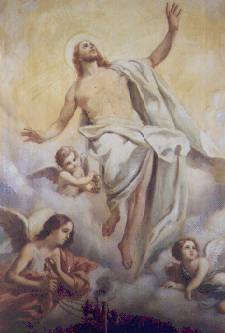
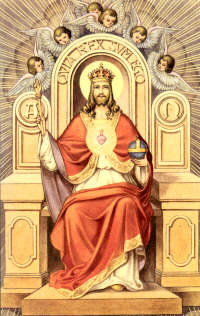
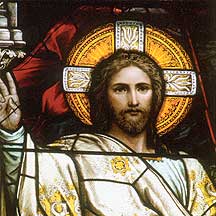
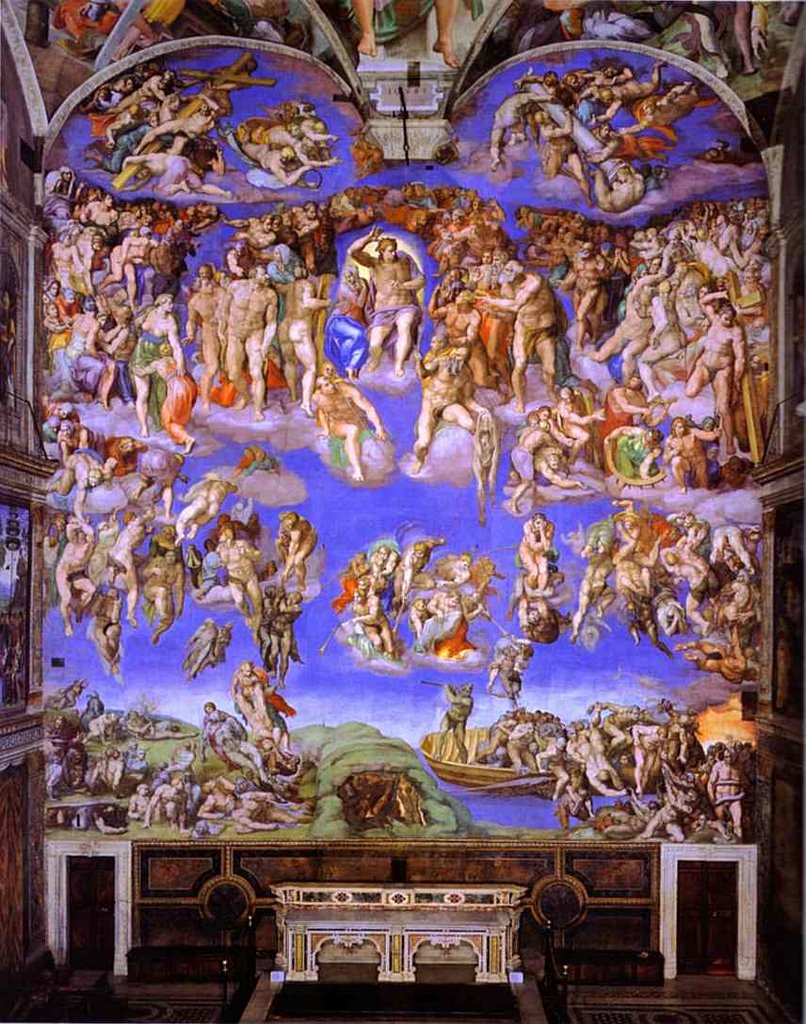


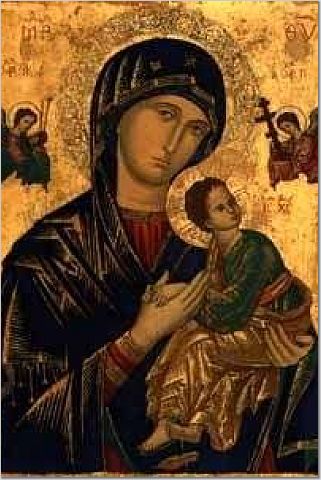



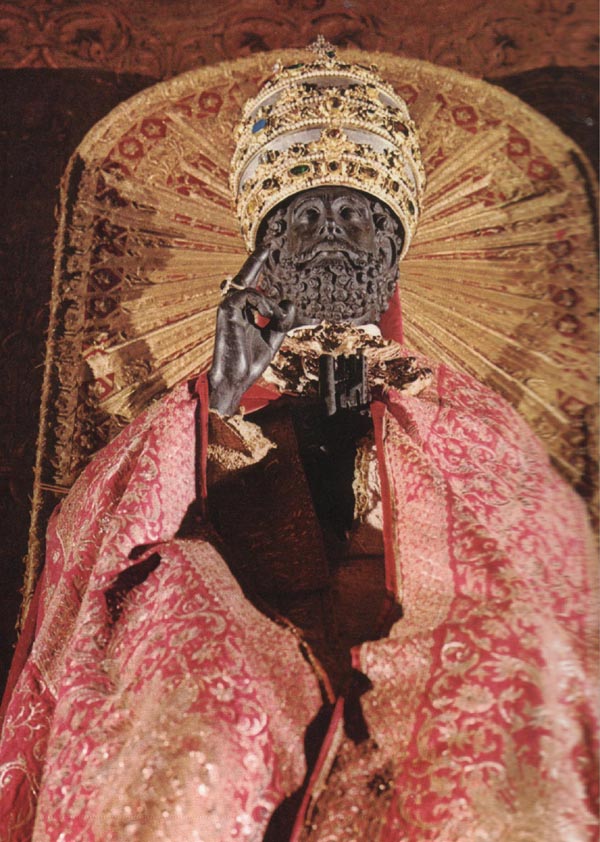


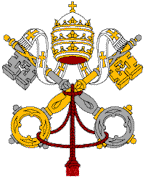


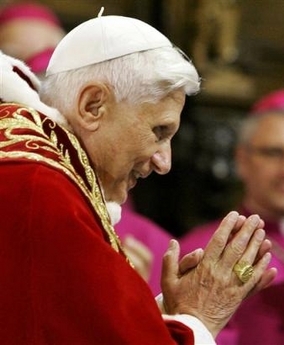






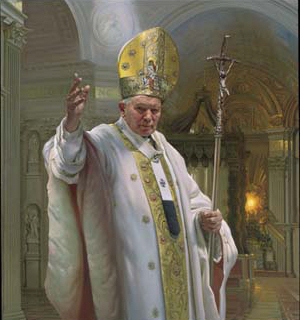
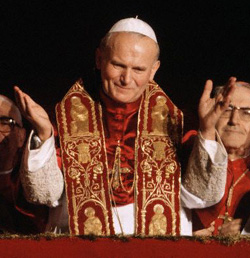
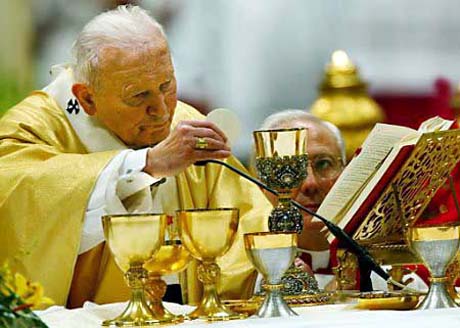
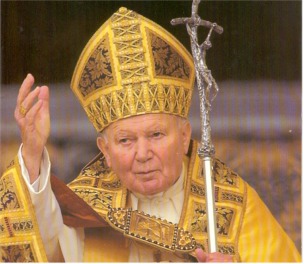






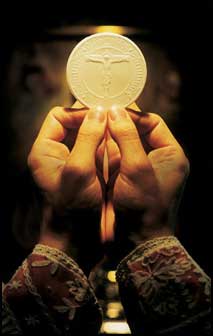
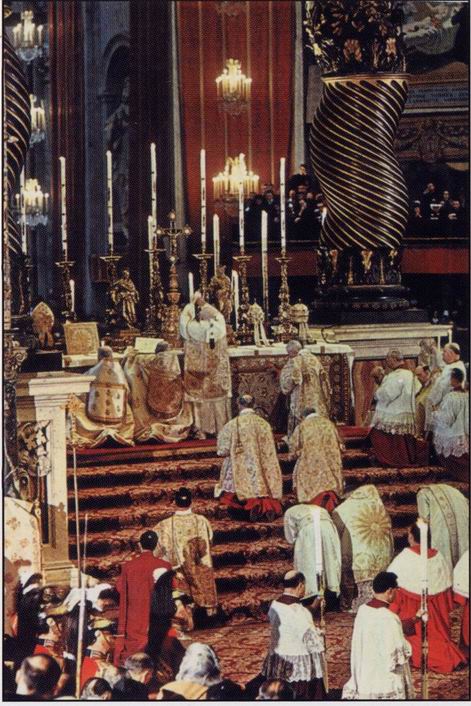

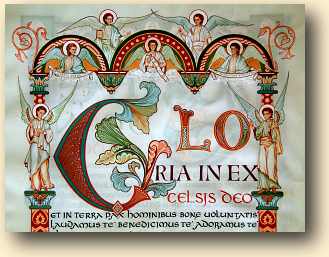

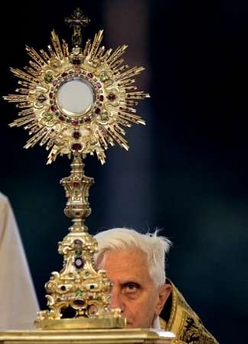


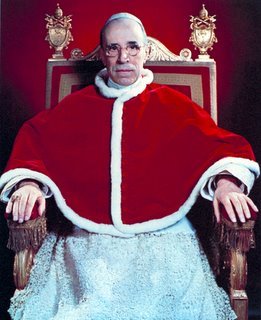




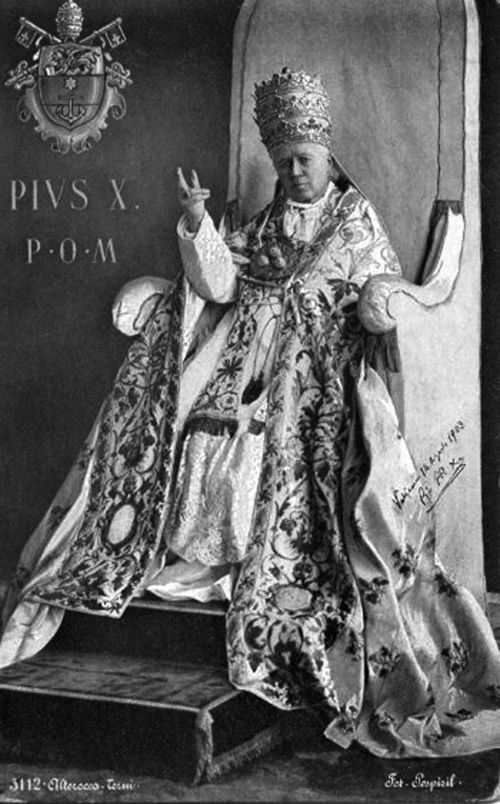



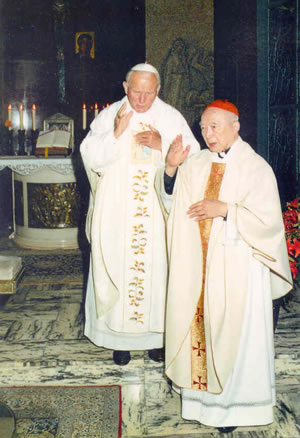






6 comments:
Jesuit heretics? What's all this?
Great post, Andrew. I'm really inspired to go learn more about St. Edmund now, especially his 10 reasons. Could be very enlightening reading in post-protestant England.
Quite a long post, but very well written & definitely worth reading.
I've never heard of Saint Josaphat before until now.
Andrew, another beautiful post. With the wonderful pictures this could almost be a small devotional booklet. Wouldn't that be great, if many Catholics created booklets of their favorites like this to share with each other? I'd have such a difficult time deciding. You did wonderfully. I do have a very warm special regard and love for St. Bernard of Clairvaux.
Another fantastic post! Where do you find the time?
Thanks for your comments, all. Paul, I did NOT manage to find the time, that's why this post has been delayed for months and it's been so long, I think the original meme-r might have forgotten about it =)
Mmajor, I think it's great that all Christians discover the saints better and take them as our role models and heroes of faith.
What a magnificent post!
Post a Comment